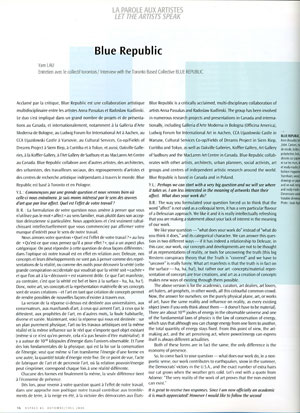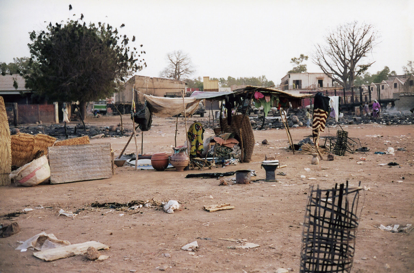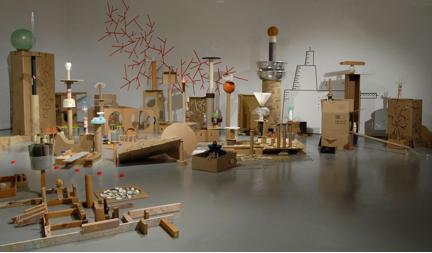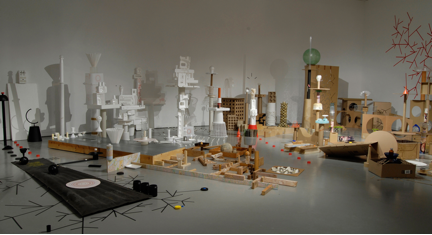
Interview with the Toronto Based Collective Blue Republic
Burying Time (Fields of Dreams), 2001 – dream records collected around the world, buried/sown in various geographic locations on-site intervention, Burkina Faso
Blue Republic is a critically acclaimed, multi-disciplinary collaboration of artists Anna Passakas and Radoslaw Kudlinski. The group has been involved in numerous research projects and presentations in Canada and internationally, including Galleria d’Arte Moderna in Bologna (Officina America), Ludwig Forum for International Art in Aachen, CCA Ujazdowski Castle in Warsaw, Cultural Services Co-op/Fields of Dreams Project in Siem Riep, Curitiba and Tokyo, as well as Oakville Galleries, Koffler Gallery, Art Gallery of Sudbury and the MacLaren Art Centre in Canada. Blue Republic collaborates with other artists, architects, urban planners, social activists, art groups and centres of independent artistic research around the world. Blue Republic is based in Canad and in Poland. www.bluerepublic.ca
Yam Lau-Perhaps we can start with a very big question and we will see where it takes us. I am less interested in the meaning of artworks than their affect. What does your work do?
Blue Republic-The way you formulated your question forced us to think that the word ‘affect’ is not used as a colloquial term, it has a very particular flavor of Deleuzian approach. We like it and it is really intellectually refreshing that you are making a statement about your lack of interest in the meaning of our work.
We have a similar feeling about your next question – ‘what does your work do’ instead of ‘what do you think it does’, and its categorical character. We can answer it in two different ways – if it has indeed a relationship to Deleuze, in this case, our work, our concepts and developments are not to be thought of as representations of reality, or tools for uncovering the truth (this big Western conspiracy theory that the Truth is “covered” and we have to “uncover” it is really funny. What art manifests is that the truth is in fact on the surface – ha, ha, ha!), but rather our art -concepts/material representation of concepts are true creations, and art as a creation of concepts makes new ways of existing through them possible.
The above version is for the academics, curators, art dealers, art lovers, art haters, art prophets, in other words, all this colourful common crowd. Now, the answer for ourselves: on the purely physical plane, art, or works of art, have the same reality and influence on reality, as every existing object, (even if you only think about them – it doesn’t have to be material). There are about 1068 jules of energy in the observable universe and one of the fundamental laws of physics is the law of conservation of energy, which says that although you can change energy from one form to another, the total quantity of energy stays fixed. From this point of view, the art-making act, and the art perceiving act, where power/energy can express itself, is always different actualities.
Both of these forms are in fact the same, the only difference is the economy of presence.
So, to come back to your question – what does our work do, in a non-poetic sense, our work contributes to earthquakes, snow in the summer, the Democratic victory in the U.S.A., and the exact number of extra hairs our cat grows when the weather gets cold. Let’s end with a quote from Adorno: “The very reality of the work of art proves that the non existent can exist.”
YL-It is great to receive two responses. Since I am now officially an academic it is much appreciated! However I would like to follow the second response for now. In Chinese aesthetic, the various forms of art (martial arts, calligraphy, Feng Shui) are events of life. In other words, they are meant to cultivate life or to “feed life” (in Chinese). Gathering from your response, I think you can relate to this.
Now I think there is an expression, a schematic organizational principal of life as ever differing forms of energy or intensities (coming back to Deleuze) in your work. This finds expressions/actualizations in many variations and embodiments in your projects. The most “simplified” expression is a recurring diagram, the one that resembles an “assemblage” of the Chinese character of the bird’s claw, which is sometimes associated with traces, movements and temporarily dwellings.
I love this diagram in your work. Perhaps this diagram is your work. Can you talk about it? Please forget that I am actually an academic if possible.

1. Beautiful Infections, 2007, red ink on paper, dimensions variable
BR-It’s really interesting that some activities have a defined existence in a different tradition. We would be careful in ascribing meaning to Beautiful Infections drawings (fig.1). Their structure, growth, progress, uncontrolled expansion, give them a look of generative art made by computer, and based on algorithmic operations like fractals or Fibonacci’s sequence. Choice is the mechanism that you have to engage in all the time: stop, change direction, start again. This means freedom in limitation but also impermanence of consequences. Jaques Derrida said something relevant to this, that “not all texts are meant to be read”. And here we approach a question of perception of art and how it is perceived BEFORE you have a chance to formulate what it means. There are places in art where the language stops, or where it should stop. These drawings-activities are a next-of-kin to our research into the idea of physio-sculpture. The aim behind those objects was to qualify space outside narrative, psychology, modern functionalism, or situationist, or environmental supra-functionalism, but to qualify space purely through direct input of information into the physiological system. We used to experiment with sound, or rather noise, and the relationship between sound and visual representation, or influence of the noise on perception. The inquiry was how the perception of different senses, like temperature, noise, pain, smell, or taste could effect visual perception and implicitly shape visual representation. An outcome was a type of psycho-physical parallelism. (There was an installation of this kind that we did for Galerie René Blouin.) And because each moment in time has a limited number of metaphors, we can easily apply the Chinese translation you’ve proposed, association with traces, movements etc., and maybe you are right, perhaps this diagram IS our work, or can be, or will be.
2. Speeding, from Beautiful Infections, 2004 – cardboard, fashion magazines, tin cans, Styrofoam, wood, metal, drawings on paper, wood and on wall, tempered found and ready-made objects, dimensions variable
3. 2. Speeding, from Beautiful Infections, 2004 – cardboard, fashion magazines, tin cans, Styrofoam, wood, metal, drawings on paper, wood and on wall, tempered found and ready-made objects, dimensions variable
YL-Sure I can relate to your thoughts. Now let us say “The Diagram”/ Beautiful Inflection is in fact a different, productive kind of abstraction from that of the traditional reductive sense of abstraction. It produces other images, connections, forms of growth and energies in new directions, such as the image of the city for example. This image is a potent one and certainty not merely a representation of an archetypal city. It is a loose, gestural conception of a “city”. I think it is neither utopic nor dystopic. Can you comment on this?
BR-It is really interesting to hear that in your perception this installation has nothing to do with either dystopian or utopian concepts. It is quite the opposite; this provisional, gestural, form of expression has something to do with the historical impermanence and failure of utopian projects, discord between the attempt and the execution (fig.2).
Beautiful Infections diagram can also represent universal semantization of the environment. There is a bipolar relation between Beautiful Infections diagram on one side, and Speeding from Beautiful Infections installation on the other. Metaphor of a city is simply a by-product. Maybe , it is descriptive of the way in which we axiomatize our behaviour, our movement, and, because most of our life is being trapped in the city, urban environment is our nature B, or second nature. Growth, multiplication, characterizes cities, so if you multiply any objects, you will get the rhythm, similar to that of a city. Tokyo, seen from the observation tower at the Roppongi Hills, looks like an enormous garbage heap. And a pile of garbage can look like a mega urban structure.
Speeding is a city-like installation constructed from odds and ends of cardboard, tin cans, plastic bottles, fashion magazines, Styrofoam, wood, metal, drawings and paintings on paper, wood and on wall, tempered found and ready-made objects, construction debris and garbage. The choice of materials is not accidental, you have to remember the basic impulse behind this project, which was my work in the slums of Brazil. Accumulation of objects in this part of the project does not represent semantic index of found objects but objects which found themselves in space within which encounter can occur. Traces of life, and things left behind reference social dimension outside of the gallery space. Here, a sense of fragmentation is compensated by connectivity – the possibilities of establishing multiple links between different spaces, as well as art object or non art-object which does not present the outcome of labour rather than labour–to-be or labour–in-itself. Everything and everyone is so busy attempting to glue back together the fragments, supporting their own existence, inventing alibis, that there is no-one left to play the role of the viewer. Everyone performs; no-one participates. It is like a performer who simultaneously belongs both to the stage and audience. The physical presence of the viewer, her/his attention, or absence of attention is part of inventory. So is the gap between self-reification and self-animation.
The thesis of Beautiful Infections project is that the condition of realization / existence / artistic act is, in a sense, unpredictable and unartistic work. So, if this project has an aspiration to be socially charged, the experience of life will be predominant. It will not just be an experience of art or no-art. Further, this project animates forms that destabilize the system of values regulating our relationship to the world; swapping of roles between the artistic and unartistic, between reality and representation, between truth and falsity in the process of dehierarchization. It also creates a situation where there is no difference between a labour-invested art object and a piece of cardboard because their autonomy can only be established through the autonomy of the whole. Their value orientation and ability to generate meaning has to be negotiated within the interconnections of objects. They exist as emblems and spatial operators. They are also tools for construction, connection and non-connection. We hope that the observer / participant will eventually be forced to question what is in front of them and perhaps look at the most ordinary objects without the indifference of someone who habitually uses them; grasping in the object not a fetishistic nature, nor an inner, simulated ecstasy, but a human, concrete, real activity, with which the object is connected.
YL-I am drawn to the sense of “realism” in your work. It is a way to mobilize art as an event in life, or a kind of “concrete activity” as you said. At the same time your work enables a certain “complication” within the “concrete” as a precondition for reflection and further action … now my last question concerns your work as a product of a collective. I am also interested in your background in having lived under a different ideology (Poland). Last of all, I am interested in how you see your work functioning within the art scene of Canada, which in general operates along more clearly demarcated lines of aesthetic, life and the political than your work?
BR-Your definition of realism is intriguing. We don’t have time to elaborate now, but it reminds us of the fact that there is a great need to reformulate/revisit key terms we are using in our culture. Realism is not understood as the accuracy of representing truth or its conquest, but as intensity or potentiality in action, a kind of Aristotelian energeia, which means being-at-work, which is an act of participation in the world. Richard Rorty used to say that most of the world is as it is whatever we think of it. We don’t think we can agree with that. The pragmatist replacement of the notion of truth with that of usefulness eliminates a big chunk of culture. And art always had a rather suspect pedigree as far as its usefulness. All the key terms like realism, society, idealism, require constant maintenance, because their meaning migrates, changes all the time. There is not much serious discussion of this, especially in regards to art, outside aphorisms. Some of these terms have died, despite the fact that we still use them, because the underlining meaning is no longer valid.
You asked about our mode of working as a collective, which is a term we dearly hate (laughter). It is a very physical, material oriented theatrical way of working, but the theatricality is understood in the spirit of Peter Brook, Grotowski rather, than the typical Buchdrama. There is no rehearsal, because rehearsal itself is a part of a play. We grew up under the “collectivist” ideology which puts us on alert when such projects are mentioned because we associate this term with ideology, which is a kind of distortion and delirium, like in Marx: …”they do not know it, but they are doing it”. Maybe this is what we can offer here as a kind of memento. Although we wouldn’t want to be relativist, things are much more complicated than they look when we remain in generalities: my great-grandfather drunk vodka with Mayakowski, my grandmother was sent to do forced labour in gulags of Kazachstan and I’ve had a relatively peaceful life. You have to add to this picture Poles’ historical mistrust of authority. Oppressive character of power was taken for granted. There were many realities – official, private, non-private, imaginary etc. that co-existed creating a schizophrenic world of surreal fragments and recombinations. The real life was somewhere else. There is a big temptation to master reality and to play God, so we have to be cautious and alert. Part of our politically and socially driven projects is an attempt to expose this inclination. Because of that, we are perhaps more aware of the fragility of any human project or construction – political, social, epistemological, merry-go-round.
Yam Lau is an artist and writer based in Toronto. He teaches painting at York University. His work is represented by the Leo Kamen Gallery in Toronto


